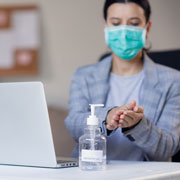4 min read
Which Parent Can Claim Child-Related Tax Breaks After Divorce or Separation?
Divorce or legal separation creates many questions. Among the most important financial considerations for couples with...
Submitted By: Julie Miller on May 26, 2020 4:46:06 PM
Chances are, employers don’t need the force of law to make them care about the health of their employees, especially during the novel coronavirus (COVID-19) pandemic. But it’s still important to know what the federal workplace safety agency—the Occupational Safety and Health Administration (OSHA)—has to say about employees returning to their jobs with a measure of confidence in their own safety.
OSHA’s recent “Guidance on Preparing Workplaces for COVID-19” report offers a helpful blueprint. However, the agency stresses it’s “only advisory in nature” and doesn’t set any new standards. Also, it falls under the underlying law’s overall requirement that employers “provide their employees with a workplace free from recognized hazards likely to cause death or serious physical harm.”
 Below are some points from the OSHA blueprint to help you consider workplace safety through a new lens.
Below are some points from the OSHA blueprint to help you consider workplace safety through a new lens.
Assess Your Risk Profile
Step one in working toward a hazard-free workplace is to make an “infectious disease preparedness and response plan,” OSHA states. (You might need to recycle your plan at some future time when another aggressive virus makes the rounds.)
Consider the sources of COVID-19 that workers might be exposed to. Those include both sources at work—namely coworkers and other people who regularly come to your workplace—and workers’ potential exposure outside work.
For example, employees who commute to work via public transportation might face a higher risk of being exposed than those who drive their own cars. Similarly, employees with spouses or family members who work on the front lines, such as in a hospital clinical setting, could pose a greater risk than others.
While you can’t discriminate against employees who might be at greater risk than others, having a complete risk exposure picture can guide your overall preparedness strategy. You might have considered that the chances of a viral outbreak at your workplace were minimal before thinking about potential indirect sources of exposure, and thus decide to take greater precautions than you otherwise would.
Workplace Control Categories
“Workplace controls” for infection prevention, as OSHA calls them, fall into four buckets:
As the above categories indicate, infection prevention measures highlighted by OSHA aren’t limited to frequent handwashing and disinfecting of workplaces. They cover work policies you might not already have in place, for example, when employees should work from home or call in sick.
And while this isn’t suggested by OSHA, you might review your paid sick leave policy to ensure that it doesn’t discourage sick employees (potentially with COVID-19) to report for duty to avoid forfeiting pay.
Other possible policy responses to consider include staggered work shifts to lower the density of employees at work at any given time, and other ways to allow workers to spread out more (“social distance”).
Employees’ Obligations
Employees should be informed of the right person or department to contact if any symptoms consistent with COVID-19 arise, and what will happen next. Ideally, you’ll have multiple options ranging from sending the employee home immediately to moving the employee’s workstation to a more remote site. “Although most worksites do not have specific isolation rooms, designated areas with doors may serve as isolation rooms until potentially sick people can be removed from the worksite,” OSHA suggests.
Not every respiratory infection is COVID-19 related, of course. But OSHA discourages employers from requiring every sick employee to obtain documentation from a healthcare professional before deciding how to handle the situation. Erring on the side of caution is the practical solution because swamped medical offices might not be able to generate such documentation.
“Risk Pyramid”
OSHA’s guidance also features a “risk pyramid” that classifies hazard levels for different kinds of jobs and workplaces. It’s encouraging to note that OSHA believes most workers “will likely fall into the lower or medium exposure risk levels.”
Jobs with “medium” exposure risk include those “that require frequent and/or close contact with people who may be infected but are not known or suspected” to be infected. The least risky (“lower exposure risk”) jobs “are those that do not require contact with people known to be, or suspected of being” infected, nor frequent contact with the general public.”
In contrast, jobs with “very high” exposure risk include healthcare workers and those who perform autopsies working with known or suspected COVID-19 patients. The next level down in the risk spectrum are jobs with just “high” exposure risk. This includes healthcare delivery personnel (for example, ambulance drivers) and medical support staff working around known or suspected COVID-19 patients.
Your infection minimization strategy and policies can be suited to the risk classification of the jobs your employees have. For example, for jobs in the “lower exposure risk” class, special engineering controls are “not recommended,” beyond any that may already be in place for risks not specifically associated with COVID-19. In contrast, some engineering controls are recommended for medium exposure risk jobs. Those include “physical barriers, such as clear plastic sneeze guards, where feasible.”
Final Thoughts
As noted, OSHA’s suggestions are merely that—suggestions and not strict requirements. It’s helpful to read the OSHA guidance to ensure you’re aware of how contagions spread. But for your company, you and your trusted managers and advisors are in the best position to evaluate the risks that exist in your workplace, and how to minimize them.
4 min read
Dec 30, 2025
Divorce or legal separation creates many questions. Among the most important financial considerations for couples with...
5 min read
Dec 26, 2025
The Free Application for Federal Student Aid (FAFSA) form for the 2026-2027 school year is now available. The FAFSA was...